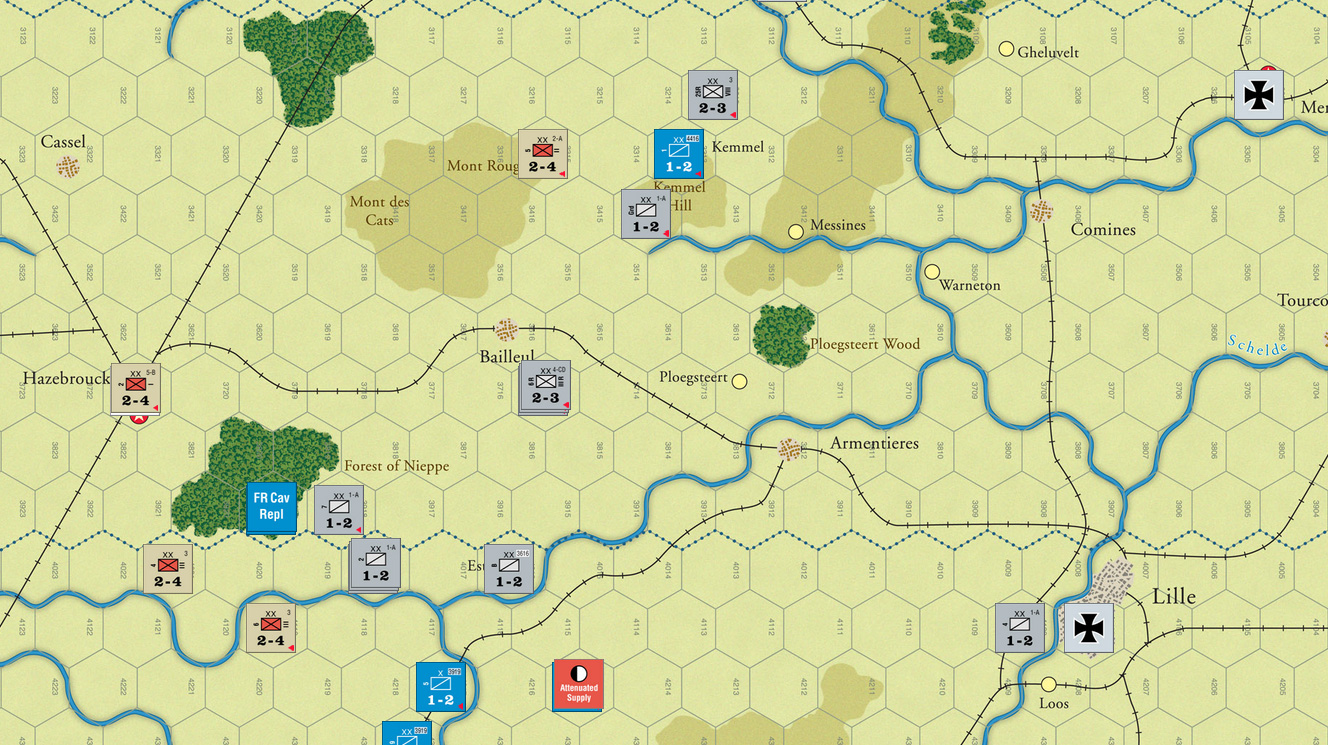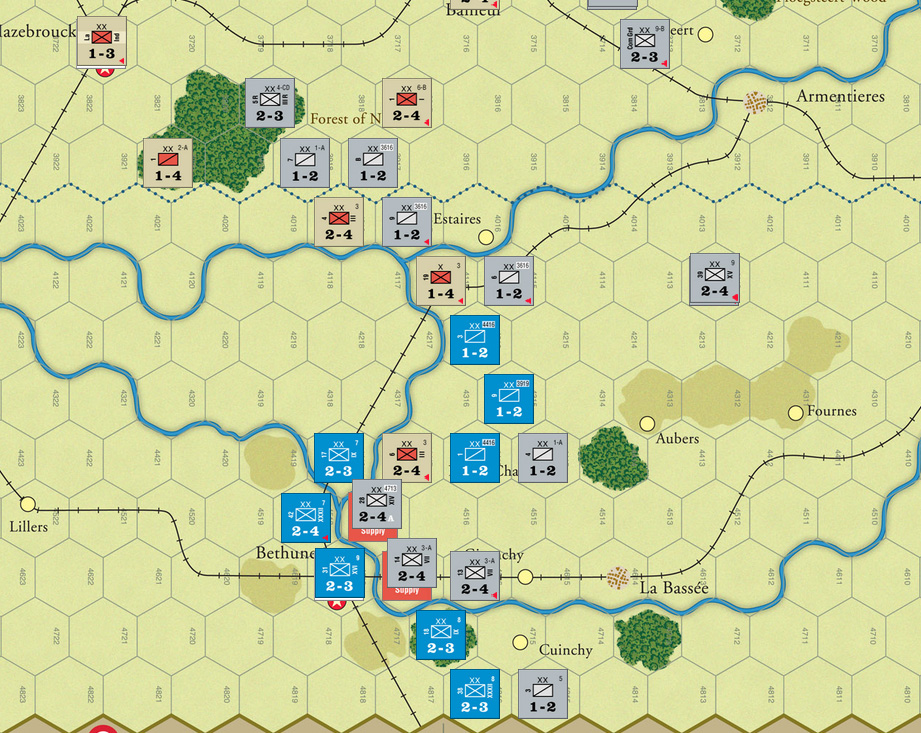Clash of Ypres
Many years ago now, Mark had me try Clash of Giants with the Galicia scenario from the second game, and I’ve been wanting to get back to it ever since. A bit ago, we started the First Ypres scenario (also from II) on Vassal.
A quick word – the Vassal module is in need of upgrades, since an attempt at marking the separate activation areas was made, and it ended up killing the hex grid. I managed to sort it out for our game. It should also have a supply of one-use markers out for the limited reinforcements and the offensive support markers (we used a grand total of one all game, because we generally forgot all about it).
I had the Germans, and after setting up the beginning reinforcements, the first chit draw was for my sector B (Menin and Hazebrouck). A good movement roll (this was a continuing theme) let me take both victory cities, and screen the Forest of Nieppe, which holds two French cavalry divisions at start. Next was Allied A (Bethune/Lille) where Mark kept the infantry back to protect Bethune and La Bassée, but the cavalry dashed forward to take Lille. Then my A went, and I occupied the other half of Lille while maneuvering on his southern flank to force a cavalry retreat from Loos. I had nothing in C (Ypres and Roulers), but Mark moved up to garrison Ypres.
Turn 2 sees the opening up of the northern flank as the Belgian army with British and French units retreat onto the map headed for the region of Nieuport. Meanwhile, the Germans get one division, in an area of their choice, which I put opposite of Roulers. Mark used rail movement to retake Hazebrouck, and I marched through Roulers with an early activation, and also set about forcing the French out of Lille (traded two cavalry divisions for one of his, thanks to poor rolls). British cavalry came in and tried to clear the way to the Forest of Nieppe, but only lost a unit in combat.
The German turn 3 reinforcements helped in ‘A’ (two divisions must come in there), and the French pulled back from Lille. Out near Fournes I swept away a cavalry division, but lost a step on an infantry division. On turn 4, Mark started taking apart my forward cordon near Hazebrouck, rescuing the French trapped there, though another bad roll cost him a step. I started putting a line together in front of the captured victory cities, and managed to take Ypres by surrounding it for a 2-1 attack (taking a step myself in the process). Mark swept back east in the south on turn 5, with me taking lots of cavalry retreats.

Mark pulled back in the north to defend the river line running SW of Nieuport as the four variable-quality German corps came on in turn 6 (in the end, three of them were TER 3 and one TER 2). Meanwhile, he had more and more to bring to bear just north of Bethune, and that area started turning into a problem for me. At this point, I just shored up my line, but I would have been better advised to fall back to a straighter line, though the main problem was a lack of good defensive terrain back there.
On turn 8, I had a British unit nicely surrounded on Mount Rouge (NE of Hazebrouck), but Mark was causing more and more trouble just south of there (then I shifted unwisely, letting him rescue the unit). The Belgians advanced up to my thin line in the north, and turned me out of Dixmunde. However, their units aren’t very good, and attacks started eroding them quickly.
I finally gave some divisions the direct purpose of securing Bruges from the French battalion that had stayed behind with some of the final large group of German reinforcements on turn 9. Much of the rest was at the south end of ‘B’ to try and shore up that problem. What turned out to be the big problem was the French snuck a cavalry division through a gap to retake Ypres. It would take far too much effort to pry out again. In the south he pried open my line again and pressed eastwards, while the Belgians looked for a better defense in the north.

I took Bruges, and pressed the Belgians, who ended up by holing up around Nieuport. This was a mistake, since all supply comes overland from the board edges, not through presumed ports. It still took a while, but there were no real challenges to the reduction of the Belgian army and that victory city after that. Meanwhile, the center was a confused mass of conflicting attempts at cutting each other off. I had something of an advantage, but I really wanted to be pressing south to rescue my position down there, and this was making it impossible.
In fact, Mark had cut off two of my units in the Forest of Nieppe, and I didn’t have much I could do about it. Worse, he railed his cavalry from Ypres to Menin and then snuck a second cavalry into Ypres. I managed to destroy the first one, but the second held out in Ypres, causing me a step loss. In front of Bethune, Mark destroyed two divisions who didn’t have a valid retreat (a third held on). Worse, my thinning line let him retake Lille the next turn, and knock out the last division on the south edge, with two cavalry divisions now stuck there, who’d been trying to rescue him.
I started cleaning up the center on turn 13, but still managed to lose steps for no progress against Ypres. On 14, the last reinforcements of the game came in to try and retake Lille. They got there, but then the French showed up with more to force a second combat if I wanted to take the city back, and took out my flanking cavalry division in the process. I lost a step on that, but did retake Lille, and got rid of three units in the center, including the cavalry holding Ypres.
Afterword
Mark conceded at that point. The game was dragging out, and I had five of the nine victory locations. I had also reduced the Belgians to three units in that combat phase, so I’d go to six in a couple turns of assaulting Nieuport. (They were going to need to keep rolling ‘1’s to survive.) Since victory is merely having the majority of victory cities, and while Mark might retake Lille, he wouldn’t get at anything else.
The chit draw system with only one combat phase per turn (special for this scenario) is an interesting bit; mostly we waited for things to line up, but especially later on, we were occasionally doing early combats to keep the other side from slipping away first.
Cavalry divisions constantly coming back makes them act like the screens they should be, but you’d think there’d be some exceptions for being cut off and then destroyed. There’s also special rules for cavalry transitioning away from this role as the front solidifies, but that never actually happened in our game. We got close mid-game, but then things broke up again.
My recollection of playing Galicia is of being stymied by poor movement rolls. That was largely not a concern here. I got a lot of 6s and 5s in the beginning portions, so when I had to worry about getting things into position, I had lots of movement to do it with.
My biggest frustration was spending lots of effort cutting off Allied units, but having Mark almost invariably get them back out, one way or another, before the two-turn out of supply could hit. (The real exception to that was the Belgian army, since it was hard to see that Nieuport wasn’t a port for supply to come through without an overland trail.)
Still, it’s a solid simple chit-pull system that works well. The combat being odds-based, but losses purely on unit quality is really interesting. I think my biggest problem there is just at this unit density you don’t see retreats, because that practically requires destroying the defender in the first place.

Discussion ¬